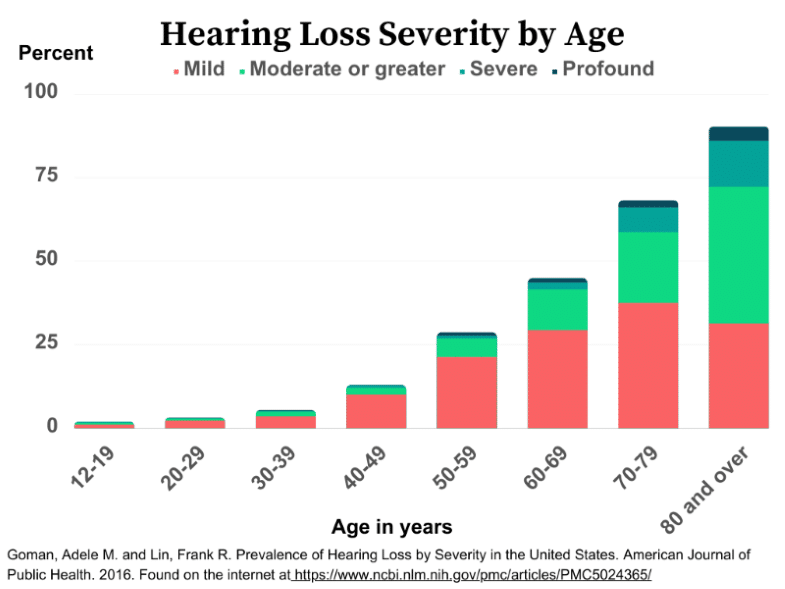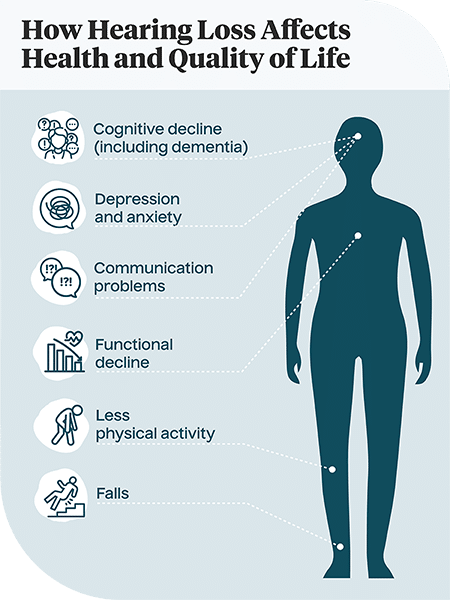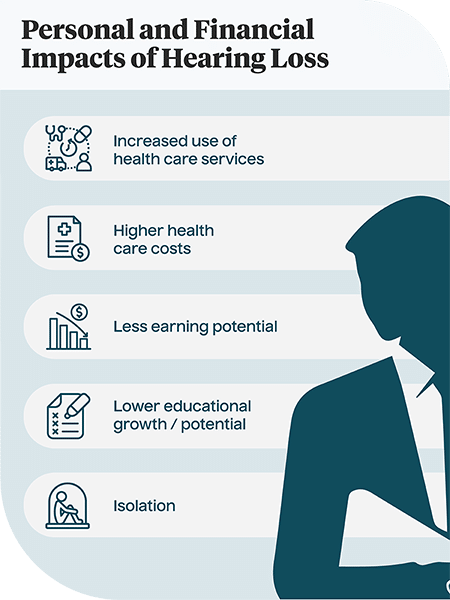Hearing Loss Is More Common Than Diabetes. Why Aren’t We Addressing It?

Hearing loss is the third most common chronic physical condition in the United States and is twice as prevalent as diabetes or cancer.
— Centers for Disease Control and Prevention 6.
Key Takeaways
- An estimated 48 million Americans currently experience hearing loss to some degree.1
- The number of Americans with hearing loss is expected to increase by 30 million in the next four decades.2
- Mild hearing loss doubles the risk of dementia, and moderate hearing loss triples it.3 Untreated hearing loss is also associated with depression, anxiety, and a higher risk of falls.
- People with untreated hearing loss are twice as likely to be underemployed or unemployed as people with normal hearing, but they spend 46% more on health care services per decade.4,5
- Those who treat their hearing loss wait an average of 10 years to do so.5 Barriers to hearing care include cost, lack of awareness, and limited access to health care services.
If asked to name the third-leading chronic health condition in the United States, most people wouldn’t choose hearing loss. Heart disease, cancer, and diabetes were common answers given to our team in a recent informal poll. But hearing loss is more common than all of those conditions, and it’s on trend to increase markedly in the coming decades.7 For the purposes of this article, we refer to hearing loss that is not considered a disability.
We wanted to understand more about how many Americans experience hearing loss, why more people aren’t seeking treatment, and what’s expected in the next few decades. Our research included examining data from national surveys and clinical studies, holding focus groups of people with hearing loss, and interviewing audiologists and hearing care patients to gather multiple perspectives.
The state of hearing loss in America
About 15.5% of American adults 18 years and over, or 40 million people, have trouble hearing according to the most recent data from the National Health Interview Survey (NHIS), a household survey administered by the Centers for Disease Control and Prevention (CDC).8
But hearing loss becomes much more common as we age. One of the most prevalent types, sensorineural hearing loss, is caused by damage to the auditory nerve or sensory cells in the inner ear—damage that can accumulate over time. In fact, nearly 80% of people age 70 and older have hearing loss in at least one ear.9
This is a major public health concern. Research has shown links between hearing loss and other conditions like dementia, depression, anxiety, and falls, all of which add up to higher health care costs and diminished quality of life.10
And the outlook is worse for people who don’t get their hearing loss treated. According to data compiled by the American Speech-Language-Hearing Association, untreated hearing loss is associated with significantly higher rates of cognitive problems, difficulty communicating, and psychosocial disorders.11 These conditions improved with consistent use of hearing aids.
How does hearing loss affect our daily lives?
Carol and Neil Thomas of White Hall, Maryland, 65 and 68 years old, respectively, both began noticing signs of hearing loss about three years ago. Understanding speech, especially in noisy settings, is the biggest challenge they face with their hearing.
Carol works in a sales position and said it’s hard to hear her customers if there is background noise behind her. “I notice more and more I don’t hear full conversations, and I have to ask people to repeat what they said.”
“We’re yelling at each other a lot to ‘say that again,’” said Neil. “I also notice that in a restaurant situation, when there’s a lot of noise, if I’m not looking directly at someone I can’t hear what they’re saying.”
We held a focus group of people with hearing loss and found that several participants could often hear other people, but they couldn’t understand the words. Brad Ingrao, AuD, said that’s often the case: “Hearing loss, for many people, is much more about hearing incorrectly than not hearing [at all].”
Having trouble understanding conversations can lead to isolation, loneliness, and depression over time as people lose connections with their loved ones and community. One focus group participant said, “My husband lost the desire to start listening and keep listening … that scared me.”

My husband lost the desire to start listening and keep listening … that scared me.
This is a very real concern for the millions of Americans dealing with hearing loss, as the condition can be misunderstood or minimized by people with normal hearing. One focus group participant with hearing loss told us she eventually stopped asking others to repeat themselves because they would become impatient. Another participant pointed out that others seem not to offer help for those with hearing difficulties the way they would for someone with vision or mobility problems.
Who’s at risk of hearing loss?
Hearing loss can affect anyone at any age, but certain factors affect your risk of developing the condition.
Age
Advanced age is the biggest predictor of hearing loss. While only 2% of Americans age 12–19 experience hearing loss in one or both ears, 68% of people in their seventies and a striking 90% of people 80 years and older are experiencing some form of hearing loss.9 The graph below also shows the extent to which the risk of moderate, severe, and profound hearing loss increases with age.

Americans are living longer, healthier lives, with an average life expectancy of 76.1 years as of 2021.12 That’s a wonderful thing, but it also raises important questions regarding age-related hearing loss: How many older adults will be dealing with the condition and its associated financial burdens and health problems in the coming years? Will insurance providers help them pay for hearing care and hearing aids?
Gender
Hearing loss is more common in men than women, with 18.5% of men and 12.3% of women ages 18 and older reporting trouble hearing in 2018.8 That can be attributed, in part, to the fact that men are more likely than women to work in jobs that expose them to excess noise, such as construction, manufacturing, and active duty military service.
Ethnicity
National data from the NHIS shows that hearing loss rates are higher among non-Hispanic whites and American Indian and and Alaska Natives than they are for Hispanic, Black, or Asian adults.8
Socioeconomic differences
With the average price of a pair of prescription hearing aids costing $4,600, they’re the third-largest purchase many people make in their lifetime after a house and a car.13 And for many Americans living on a limited budget or fixed income, that price is too high to pay. When we conducted a survey of hearing aid users, the most common complaint we heard about hearing aids was that “they’re expensive.”
Unfortunately, that can mean millions of people with hearing loss go untreated, which often leads to other health issues and higher health care costs over time.5
Health care access
About 14% of Americans live in rural areas with limited access to health care facilities.13 One study found rural residents had to drive twice as far to see a hearing specialist compared to those living in urban areas.15
In addition to living farther away from health care facilities, our country is facing a shortage of health care professionals in many fields, including audiology. We spoke to Nicholas Reed, AuD, an audiologist at Johns Hopkins University in Baltimore, Maryland. He raised concerns about the limited number of hearing professionals available to treat people with hearing loss.

There is a dearth of audiologists, in fact it’s actually a shrinking profession relative to the fact that hearing loss is growing because we have an aging society. There aren’t enough hearing instrument specialists to fill the gap either.
— Dr. Nicholas Reed, Johns Hopkins University
The lack of hearing professionals is of particular concern for rural Americans, as data from the United States Department of Agriculture shows rural areas tend to have older populations compared to urban regions, and the trend is growing: The number of rural residents over the age of 65 grew by 22% from 2010 to 2020.14
Reasons for this change include baby boomers entering their 60s and 70s, and more people moving to rural retirement communities. It’s clear that older adults in rural areas face a double challenge when it comes to hearing: higher rates of age-related hearing loss and less access to in-person hearing care.
Noise exposure
Exposure to excessive noise is a growing cause of hearing loss for millions of Americans, both young and old. Both short-term and repeated noise exposure can cause lasting damage to the inner ear, resulting in permanent hearing loss. It’s a particular risk for teenagers, those who work around loud equipment, and military service members.
According to the CDC, 22% of Americans work in an environment with unsafe noise levels,16 and 12.5% of children between 6 and 19 have some degree of hearing loss caused by listening to audio devices (particularly earbuds) turned up too loudly.17
Hearing exam data from more than 7,000 teenagers across the country found that up to 17.5% of teenagers have some degree of hearing loss,18 and a 2020 survey conducted by the CDC reported that 73.6% of teenagers were exposed to loud noise at school. The majority of those students weren’t provided with hearing protection.19
Many people who are exposed to loud noise, whether through music, equipment, or recreational activities, don’t realize the damage it’s causing to their ears until they have noticeable hearing loss, which often shows up as difficulty understanding conversations. Wearing earplugs or other protection and avoiding high volume when listening to music through headphones are important precautions for preserving your hearing.
It may get worse before it gets better
National data show the number of Americans ages 20 and older with hearing loss increased from approximately 38 million in 2010 to an estimated 44 million in 2020. That trend is set to continue into the foreseeable future, with hearing loss predicted to affect 73.5 million Americans by 2060, according to a 2017 article published by researchers at Johns Hopkins University.2

The authors noted, “During the next 43 years, the number of people with hearing loss in the United States is projected to almost double and will outpace the overall population growth rate, given the distribution shift toward older adults.”
The incidence of moderate and severe hearing loss is predicted to rise more quickly than mild hearing loss, which could lead to worse health outcomes and greater financial burdens for individuals, their families, and the nation as a whole.
Why aren’t people seeking treatment?
Although 37.5 million Americans, or 15% of adults, have some degree of perceived hearing loss, only one in six people between the ages of 20 and 69 have ever used hearing aids.19 And even people who do treat their hearing loss wait about 10 years before getting help.6

Frank Lin, MD, PhD, director of the Johns Hopkins Center for Cochlear Hearing and Public Health in Baltimore, Maryland, explained some of the reasons people don’t seek hearing treatment.
“Everyone loses hearing as we age,” said Lin, “so there’s a need without a doubt. But what’s not happened in the past is the conversion of need into demand. There are a lot of reasons for that: Hearing aids are expensive and there’s a stigma [associated with wearing them], but we think one fundamental barrier is just an understanding and awareness of hearing.”
The FDA also outlined the following three barriers to hearing aid usage in their final rule on OTC hearing aids, which hit the market in October 2022.21
- High cost of hearing care
- Consumers’ concerns they will look or feel “old” with hearing aids
- Expectations that the cost of hearing aids won’t be worth it compared to the amount of hearing improvement
While the stigma of wearing hearing aids is an obstacle we’ve heard often from hearing professionals, the majority of participants in our focus groups and personal interviews said they didn’t worry about how they’d look with a hearing aid. We did find, though, that people who still work full-time tend to be more concerned about the look of a hearing aid and would prefer a small device that isn’t noticeable.
The good news is that hearing aid technology and design have made huge strides in the past few decades. Manufacturers of both OTC and prescription hearing aids now make devices that are virtually invisible and include capabilities like Bluetooth streaming, rechargeable batteries, directional microphones, and background noise reduction. If cost is a deciding factor for you, check out the best affordable hearing aids.
How untreated hearing loss damages your health
But as Lin noted, many people simply don’t realize the importance of hearing health. It’s not an understatement to say hearing ability is directly related to your overall health and quality of life.
That’s because although your ears take in sound, it’s your brain that processes the sound signals and gives them meaning. In effect, although hearing is thought of as a function of the ear, it’s actually a job performed by the brain.
And we know untreated hearing loss results in the brain processing less sound, which leads to certain pathways dying over time or getting recruited for other processes like sight. This, in turn, may cause a host of other problems, such as dementia, balance issues (and the falls that may result), depression, and more.

For example, research shows that people with mild hearing loss are at twice the risk of developing dementia, and those with moderate hearing loss have triple the risk.3 Take a look below to learn about other financial impacts of untreated hearing loss.10

Research also shows even mild hearing loss in children interferes with the following:22
- Ability to follow classroom discussions
- Auditory pathways in the brain
- Communication skills
- Learning ability (including reading)
- Working memory
Coping with hearing loss: What you can do
The longer people wait to treat their hearing loss, the more likely they are to have limited success with hearing aids and face more of the health issues associated with hearing loss.
Get an annual hearing exam
Even if you feel you don’t have problems with your hearing, it’s a good idea to have your hearing checked at your doctor’s office each year. If you’re told you have issues with your hearing, follow up at a hearing care clinic staffed with an audiologist or hearing instrument specialist. They will perform a thorough physical ear exam as well as an audiometry exam, in which your ability to hear speech and tones at different frequencies will be tested.
Know your Hearing Number

The Hearing Number is a public awareness campaign spearheaded by Lin at the Cochlear Center for Hearing and Public Health as a way for people to understand their hearing ability using one number, and to easily keep track of it over time.
You can either use your audiogram results from a hearing exam to calculate your Hearing Number, or you can test your hearing with the Mimi app, which is currently available for iPhones.
Communication strategies and hearing aids
It’s also important to use techniques for better communication, such as looking directly at people you’re speaking with and turning on closed captioning on TVs and computers. And if you know you have hearing loss, look into buying hearing aids.
Have questions about this review? Email us at reviewsteam@ncoa.org.
Sources
- Hearing Loss Association of America. Hearing Loss Facts and Statistics. Found on the internet at https://www.hearingloss.org/wp-content/uploads/HLAA_HearingLoss_Facts_Statistics.pdf
- Goman, Adele M., et al. Addressing Estimated Hearing Loss in Adults in 2060. JAMA – Otolaryngology Head & Neck Surgery. July 2017. Found on the internet at https://www.ncbi.nlm.nih.gov/pmc/articles/PMC5824202/
- Lin, Frank R., et al. Hearing Loss and Incident Dementia. Archives of Neurology. Feb. 2011. Found on the internet at https://jamanetwork.com/journals/jamaneurology/fullarticle/802291
- Emmett, Susan D and Francis, Howard W. The Socioeconomic Impact of Hearing Loss in US Adults. Otology and Neurotology. March 2015. Found on the internet at https://www.ncbi.nlm.nih.gov/pmc/articles/PMC4466103/
- Reed, Nicholas J, et al. Trends in Healthcare Costs and Utilization Associated With Untreated Hearing Loss Over 10 Years. JAMA Otolaryngology Head Neck Surgery. January 2019. Found on the internet at https://www.ncbi.nlm.nih.gov/pmc/articles/PMC6439810/
- Johns Hopkins University. The Hidden Risks of Hearing Loss. Found on the internet at https://www.hopkinsmedicine.org/health/wellness-and-prevention/the-hidden-risks-of-hearing-loss
- Centers for Disease Control and Prevention. Loud Noise Can Cause Hearing Loss. Found on the internet at https://www.cdc.gov/nceh/hearing_loss/public_health_scientific_info.html
- National Center for Health Statistics. Percentage of any difficulty hearing for adults aged 18 and over, United States, 2019—2022. National Health Interview Survey. Found on the internet at https://wwwn.cdc.gov/NHISDataQueryTool/SHS_adult/index.html
- Goman, Adele M. and Lin, Frank R. Prevalence of Hearing Loss by Severity in the United States. American Journal of Public Health. 2016. Found on the internet at https://www.ncbi.nlm.nih.gov/pmc/articles/PMC5024365/
- Nieman, Carrie L., et al. Racial/Ethnic and Socioeconomic Disparities in Hearing Health Care Among Older Americans. Journal of Aging Health. February 2016. Found on the internet at https://www.ncbi.nlm.nih.gov/pmc/articles/PMC4826391/
- American Speech-Language-Hearing Association. Untreated Hearing Loss in Adults. January 2012. Found on the internet at https://www.asha.org/articles/untreated-hearing-loss-in-adults/
- U.S. Department of Health and Human Services. Provisional Life Expectancy Estimates for 2021. August 2022. Found on the internet at https://www.cdc.gov/nchs/data/vsrr/vsrr023.pdf
- Lin, Frank R. Time for a Top-Down Approach to Hearing Aid Affordability and Accessibility. American Journal of Public Health. February 2018. Found on the internet at https://www.ncbi.nlm.nih.gov/pmc/articles/PMC5846613/
- Davis, James C., et al. Rural America at a Glance. Nov. 2022. Found on the internet at https://www.ers.usda.gov/webdocs/publications/105155/eib-246.pdf?v=686.2
- Chan, Stephen, et al. Rurality and Determinants of Hearing Healthcare in Adult Hearing Aid Recipients. The Laryngoscope. October 2017. Found on the internet at https://www.ncbi.nlm.nih.gov/pmc/articles/PMC5537053/?report=reader
- Centers for Disease Control and Prevention. Preventing Noise-Induced Hearing Loss. July 21, 2022. Found on the internet at https://www.cdc.gov/ncbddd/hearingloss/noise.html
- Centers for Disease Control and Prevention. Noise and Occupational Hearing Loss. June 6, 2023. Found on the internet at https://www.cdc.gov/niosh/topics/noise/default.html
- Su, Brooke M. and Chan, Dylan K. Prevalence of Hearing Loss Among US Children and Adolescents. JAMA – Otolaryngology Head & Neck Surgery. September 2017. Found on the internet at https://www.ncbi.nlm.nih.gov/pmc/articles/PMC5710291/
- Centers for Disease Control and Prevention. Survey of Teen Noise Exposure and Efforts to Protect Hearing at School—United States, 2020. Dec. 4, 2020. Found on the internet at https://www.cdc.gov/mmwr/volumes/69/wr/mm6948a5.htm
- National Institute on Deafness and Other Communication Disorders. Quick Statistics About Hearing Loss. March 25, 2021. Found on the internet at https://www.nidcd.nih.gov/health/statistics/quick-statistics-hearing
- Federal Register. Medical Devices; Ear, Nose, and Throat Devices; Establishing Over-the-Counter Hearing Aids. Aug. 17, 2022. Found on the internet at https://www.federalregister.gov/documents/2022/08/17/2022-17230/medical-devices-ear-nose-and-throat-devices-establishing-over-the-counter-hearing-aids
- Moore, David R., et al. Minimal and Mild Hearing Loss in Children: Association With Auditory Perception, Cognition, and Communication Problems. Ear and Hearing. July 2019. Found on the internet at https://www.biorxiv.org/content/10.1101/723635v1
